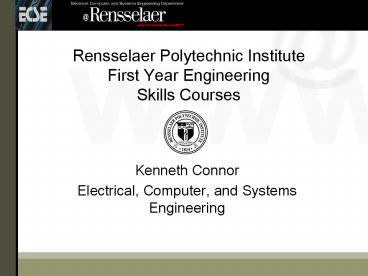Rensselaer Polytechnic Institute First Year Engineering Skills Courses - PowerPoint PPT Presentation
1 / 20
Title:
Rensselaer Polytechnic Institute First Year Engineering Skills Courses
Description:
They learn how to fabricate a simple semiconductor p-n junction. During this session, they will fabricate a silicon solar cell used for ... – PowerPoint PPT presentation
Number of Views:157
Avg rating:3.0/5.0
Title: Rensselaer Polytechnic Institute First Year Engineering Skills Courses
1
Rensselaer Polytechnic InstituteFirst Year
Engineering Skills Courses
- Kenneth Connor
- Electrical, Computer, and Systems Engineering
2
First Year Skills Courses
- Engineering Processes
- John Szczesniak
- Engineering Graphics and CAD
- Doug Baxter
- Introduction to Engineering Electronics
- Paul Schoch, Ken Rose, Bruce Carlson, Partha
Dutta, Bill Mielke
3
EE First Year Schedule
- Fall Credit Hours
- ENGR-1100 Intro. to Engineering Analysis 4
- ENGR-1310 Intro. to Eng. Electronics 1
- ENGR-1500 Chemistry of Materials I 4
- MATH-1010 Calculus I 4
- Humanities or Social Sciences Elective 4
- Spring Credit Hours
- ENGR-1200 Engineering Graphics CAD 1
- MATH-1020 Calculus II 4
- CSCI-1100 Computer Science I 4
- PHYS-1100 Physics I 4
- Humanities or Social Sciences Elective 4
4
CSE First Year Schedule
- Fall Credit Hours
- ENGR-1200 Engineering Graphics CAD 1
- ENGR-1500 Chemistry of Materials I 4
- CSCI-1100 Computer Science I 4
- MATH-1010 Calculus I 4
- Humanities or Social Sciences Elective 4
- Spring Credit Hours
- ENGR-1100 Intro. to Engineering Analysis 4
- ENGR-1310 Intro. to Eng. Electronics 1
- MATH-1020 Calculus II 4
- CSCI-1200 Computer Science II 4
- Humanities or Social Sciences Elective 4
5
Engineering Processes
- The use of basic machine tools such as
lathes, milling machines, drill presses, band
saws, and grinders, including micrometers,
vernier calipers, and other devices of use in a
machine shop or laboratory. Welding techniques
and tool making are also considered. - Fall, spring, and summer terms annually. 1 credit
hour, 3 contact hours
6
Engineering Processes
- Cannon/Catapult Project
- Lathe
- Vertical Miller
- Gas Metal Arc Welding and Oxyacetylene Brazing
Lab - Plastic Welding Lab
- Misc
- Measurement Tools
- Grinding
- SAFETY
- Final Exam
7
Engineering Graphics and CAD
- An introduction to the techniques for
creating solid models of engineering designs.
Topics include three-dimensional modeling of
parts and assemblies, visualization, orthographic
and isometric free-hand sketching, and
computer-generated design documentation. - Fall, spring, and summer terms annually. 1 credit
hour, 3 contact hours
8
EGCAD Self-Taught Solid Modeling
- SolidWorks
- Solid Modeling Software on Laptops
- PDMWorks
- Secure Data Base Manager on Laptops
- Course CDs
- 2 CDs
- Lectures 1-6
- Lectures 7-12
- Video Lectures
- 4 to 5 15 Minute Segments / Lecture
- Manual and Course Problems
9
EGCAD Web Interface
- WebCT and Traditional Internet Pages
- Display Video Lectures
- Lecture Data (Parts, Assemblies, etc.)
- Quizzes
- Weekly Quizzes
- Laboratory Quizzes
- Course Information
- Student Projects
10
EGCAD Online Quizzes
11
EGCAD Viewing the Lecture Online
12
Introduction to Engineering Electronics
- A hands-on experience with electronic
circuits and modern opportunities to build and
test simple electronic circuits that illustrate
basic concepts. A design project is included. - Fall and spring terms annually. 1 credit hour, 3
contact hours
13
IEE Principles and Goals
- Hands-on laboratory and design experiences build
student confidence, stimulate curiosity, and
demonstrate the relevance of engineering work
thereby increasing motivation and retention. - Build on students limited tinkering experiences
to build and sustain interest in engineering
(particularly electrical, computer and electric
power). - Give students first-hand experience with
electronic circuits chosen to demonstrate that
engineering work is relevant, rewarding, and even
fun. - Prepare students for design activities in the
rest of their undergraduate engineering courses.
14
IEE Activities
- Basic Instrumentation
- Oscilloscope, Digital Multimeter,
- Function Generator, DC Power Supplies
- Voltage, Current, and Power
- Series and Parallel Resistance, Voltage Dividers
- AC and DC voltage measurements
- Diodes and Transistors
- Binary Counter
- 555 Timer
- 7-segment LED display
- Stepper motors
- IR communication
- Flash camera
- Magnetic-Levitation controller
15
IEE Course Structure
- 11 One Hour Lectures
- 11 Two Hour Labs
- Tutorials, Lectures, and Labs on WebCT
16
IEE Flash Camera
17
IEE Flash Camera Light Sensitive Trigger
18
IEESolar Cell
- In this laboratory session, students are
introduced to microelectronics fabrication
technologies. They learn how to fabricate a
simple semiconductor p-n junction. During this
session, they will fabricate a silicon solar cell
used for generating electric power directly from
sunlight. The fabrication of this device is
implemented in the class 100 clean room
environment.
19
IEE Solar Cell
- Wafer Handling
- Impurity Diffusion
- Metalization
- Photolithography
- Contact Annealing
- Device Testing
20
IEE Evaluation Key Results
- Most students would recommend IEE to their
friends and they were more satisfied with their
education as a result of taking IEE. - An increase in student confidence was marginal
during the course itself. However, when the
students were surveyed again in Introduction to
Engineering Design, the most positive result was
in response to the statement, IEE helped prepare
me to complete the design projects in IED. - The most satisfying observation is that
improvements in motivation and confidence can be
measured in subsequent semesters for this 1
credit course.































